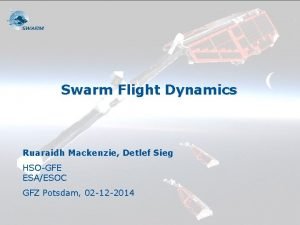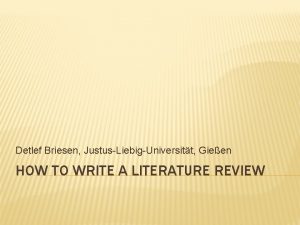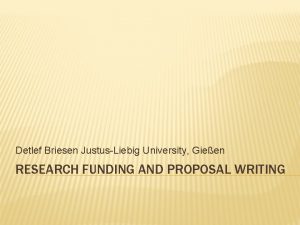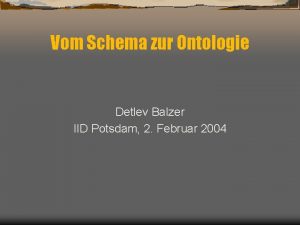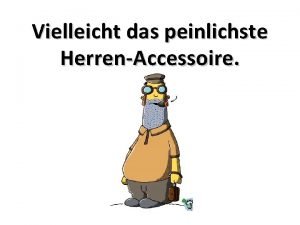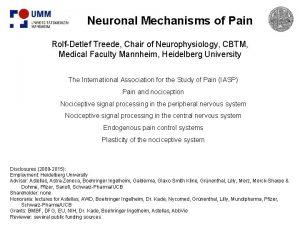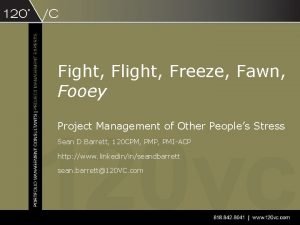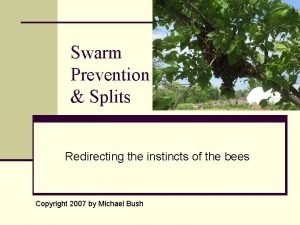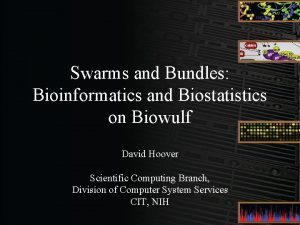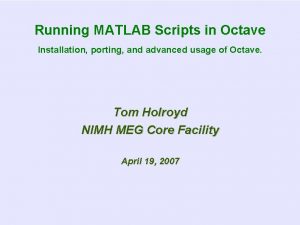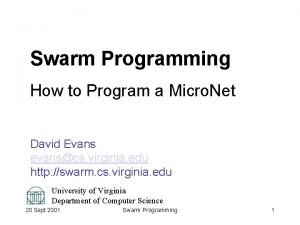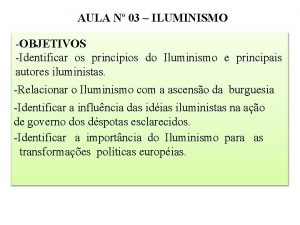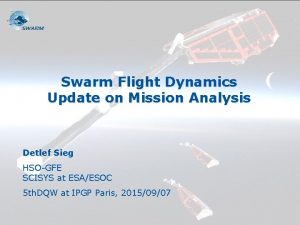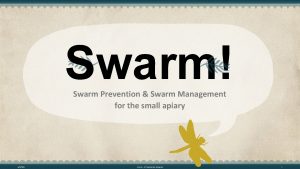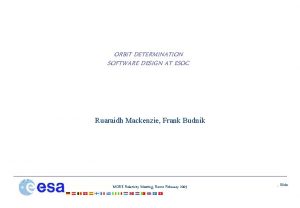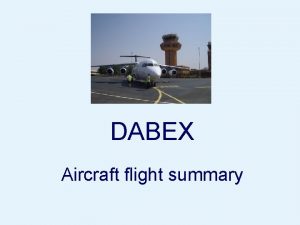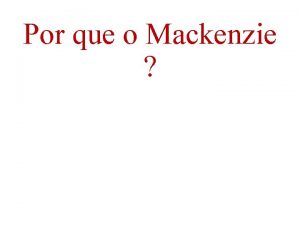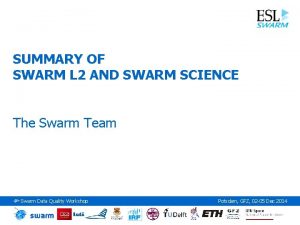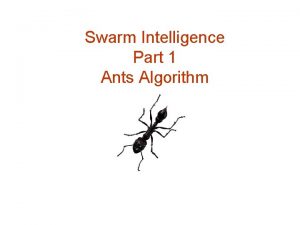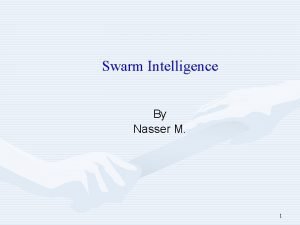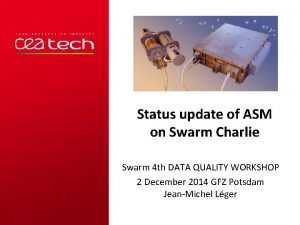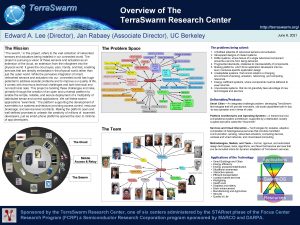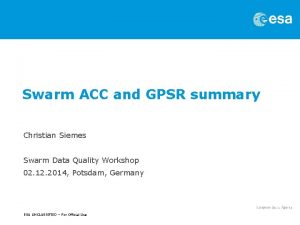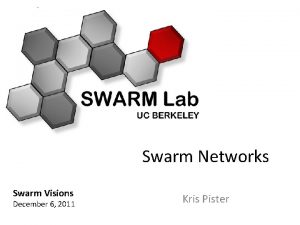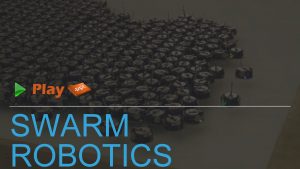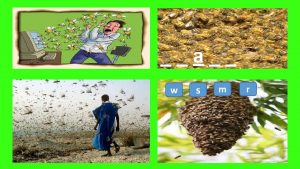Swarm Flight Dynamics Ruaraidh Mackenzie Detlef Sieg HSOGFE




















- Slides: 20

Swarm Flight Dynamics Ruaraidh Mackenzie, Detlef Sieg HSO-GFE ESA/ESOC GFZ Potsdam, 02 -12 -2014

Swarm Orbit History

hours Swarm Orbit History

Degrees Swarm Orbit History

hours Swarm Orbit History /year ours 1. 5 h

Swarm Orbit History

Swarm Orbit History

Swarm Orbit History NRLMSISE-00

Swarm Orbit History

Swarm Orbit History

Swarm Orbit History

Swarm Orbit History

Swarm Orbit History

Swarm Orbit History

Impact of Swarm C ASM loss • FDS needs to understand whether loss of ASM on SW-C and associated need to cross calibrate levies any additional requirements on lower pair constellation. For example: • Do SW-A and SW-C need to fly closer together? • What is meant by closer together? Full orbit, short interval in orbit? • For how long and how frequently does this need to happen? • Once additional requirements are understood we can analyse how to safely implement them and assess the costs in terms of fuel and operations effort. • Note that changes to the constellation, especially flying closer together, incurs extra risk, requires more frequent manoeuvring and requires more detailed daily assessment of in-orbit performances and so should only be requested if required for mission success.

Plans for Long Term Evolution • Current upper-lower constellation (Dinc =0. 4 deg, Da = 47 km) increases RAAN separation between lower pair and upper spacecraft by 1. 5 hours per year. • At end of 2014 separation will be 1. 3 h. • Rate of separation increase can be decreased, for example: • 40 kg fuel SW-B Dinc = 0. 1 deg, 0. 6 h/y • 27 kg fuel SW-B Dinc = 0. 2 deg, 0. 9 h/y • If we change SW-B inclination by -0. 2 degrees once we get to 4 hours RAAN separation around October 2016 we can drift to 8 hours RAAN separation by early 2021. • Also possible to lower the SMA so that the lower pair are targeted to reach 300 km altitude at end of this 4 year period, or even earlier for 20 m/s delta-v per spacecraft.

Swarm Orbit History DRAAN SWA-SWB 8 h 6 h 4 h

Altitude at node crossing (km) Swarm Orbit History DV = 22 ms 20 kg

• An example could be • Fly lower pair crossing equator at same time each orbit • Pole crossing times would be 1 second apart • In the event of a safe mode of trailing spacecraft a radial crossing would occur after 12 orbits with a separation of 140 in height. • This would require maintenance of eccentricity difference at current levels and weekly manoeuvres to maintain separation. • Extra fuel cost would most likely be not very significant since the manoeuvres would be smaller than now but more frequent • NEEDS TO BE INVESTIGATED CAREFULLY WHETHER THIS IS REALLY PRACTICAL.

Summary In order to plan the remainder of the mission some issues need to be resolved: • Does ASM cross calibration add any new requirements on the lower constellation? • Is a drift from 4 -8 hours LTAN separation between lower and upper spacecraft between late 2016 and early 2021 acceptable? • The time when the lower pair’s orbit decays freely to 300 km altitude is roughly 2025, depending on the solar activity evolution. Should we accelerate the altitude decay of the lower pair to 300 km, and thus shorten the mission duration? Once we have these consolidated inputs from the scientists we can assess whether they can be implemented and what the operational consequences are.
 Detlef sieg
Detlef sieg Detlef briesen
Detlef briesen Detlef briesen
Detlef briesen Detlef balzer
Detlef balzer Detlef täschchen
Detlef täschchen Detlef wilkening
Detlef wilkening Rolf-detlef treede
Rolf-detlef treede Fight flight freeze fawn
Fight flight freeze fawn Hegering agger sieg
Hegering agger sieg Sieg seg guanajuato gob mx calificaciones
Sieg seg guanajuato gob mx calificaciones Es ist vollbracht er hat den sieg
Es ist vollbracht er hat den sieg Sieg formation
Sieg formation Datacore swarm
Datacore swarm Swarm prevention split
Swarm prevention split Biowulf swarm
Biowulf swarm Newsflash swarm
Newsflash swarm Swarm theory reading answers
Swarm theory reading answers Run matlab script in octave
Run matlab script in octave Swarm programming
Swarm programming Mackenzie sp o iluminismo ideologia
Mackenzie sp o iluminismo ideologia Tynan mackenzie
Tynan mackenzie
